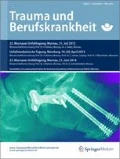Zusammenfassung
Zur operativen Versorgung von horizontal oder vertikal instabilen Schultereckgelenksprengungen kommt eine große Bandbreite an Operationstechniken in Frage, z. B. die Stabilisierung mittels Zuggurtung, Hakenplatte oder Bosworth-Schraube. Viele dieser Verfahren gehen oft mit verschiedenen Komplikationen einher, sodass eine stabilisierende, komplikationsarme und gleichzeitig annähernd physiologische operative Versorgung immer mehr in den Mittelpunkt des wissenschaftlichen Interesses rückte. Durch Weiterentwicklung des dynamischen TightRope®-Systems in der Syndesmosenchirurgie besteht nun seit einigen Jahren die Möglichkeit, instabile Akromioklavikulargelenksprengungen in ähnlicher Art und Weise zu versorgen. Vorteile sind u. a. eine verbesserte Kosmetik durch einen weniger belastenden operativen Zugang sowie die Reduktion der postoperativen Infekte und die Tatsache, dass ein Zweiteingriff zur Entfernung der einliegenden metallischen Implantate nicht mehr notwendig ist. Im Rahmen von biomechanischen Studien konnte nachgewiesen werden, dass die TightRope®-Versorgung eine stabile Situation schaffen kann und für eine ausreichende Belastbarkeit sorgt.
Abstract
Surgical treatment of horizontally or vertically unstable acromioclavicular (AC) joint dislocations covers a wide range of surgical techniques, e.g. stabilization via a tension band, hooked tie plate or Bosworth screw. Many of these techniques are often accompanied by various complications so that a stabilizing, low complication and approximately physiological surgical treatment has moved increasingly into the focus of scientific interest. Through further development of the dynamic TightRope® system in syndesmosis surgery there is now the possibility to treat unstable AC joint dislocations in a similar manner. Advantages include improved cosmetic aspects through a less stressful surgical access as well as the reduction of postoperative infections and the fact that a second intervention to remove the metal implants is no longer necessary. Within the framework of biomechanical studies scientists were able to show that the TightRope® treatment was able to create a stable situation and to provide a sufficient load capacity.




Literatur
Habermeyer P, Agneskirchner JD (2002) Schulterchirurgie. Urban & Fischer, München Jena
Hensler D, Imhoff AB (2011) Minimalinvasive Schultereckgelenkstabilisierung mit freiem Sehnentransplantat. Obere Extremität 6(2):99–107
Imhoff B, Tennant D (2009) Arthroscopic anatomic stabilization of acute acromioclavicular joint dislocation using the tightrope® system. Arthrex, Karlsfeld/München
Müller M (2006/2007) Chirurgie für Studium und Praxis. Medizinische Verlags- und Informationsdienste, Breisach
Pieper HG, Dann K (2011) Engelhardt Lexikon Orthopädie und Unfallchirurgie. Springer, Berlin Heidelberg New York
Walz L, Salzmann GM, Fabbro T et al (2008) The anatomic reconstruction of acromioclavicular joint dislocations using 2 tightrope devices. Am J Sports Med 36(12):2398–2406
Wellmann M, Smith T, Windhagen H, Siebert CH (2011) Biomechanik aktueller Rekonstruktionstechniken bei Schultereckgelenksprengungen. Obere Extremität 6(2):85–89
Interessenkonflikt
Die korrespondierende Autorin gibt an, dass kein Interessenkonflikt besteht.
Author information
Authors and Affiliations
Corresponding author
Rights and permissions
About this article
Cite this article
Blessing, A., Grützner, P. & Studier–Fischer, S. TightRope® . Trauma Berufskrankh 13, 264–268 (2011). https://doi.org/10.1007/s10039-011-1813-1
Published:
Issue Date:
DOI: https://doi.org/10.1007/s10039-011-1813-1

